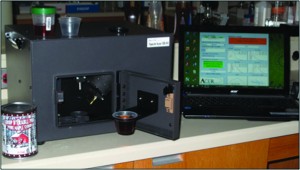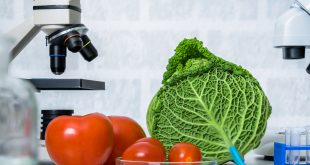Alain Clément1 | Bernard Panneton2 | Nathalie Martin3 | Luc Lagacé3*
Every spring, when daytime temperatures rise above the freezing point and night-time temperatures are below zero, the sap in maple trees starts moving from the roots to the stem. This sap contains everything the tree needs to prepare for the growing season: water, sugars, amino acids, vitamins, etc. Abundant sap in maple trees is collected by simply inserting a spout in its trunk. Maple sap is collected, and then boiled to evaporate water until sugar content reaches a level of 66%. The resulting syrup is light colored at the beginning of the harvesting season and much darker towards the end. Its delicate taste, that has attracted the interest of Canadian consumers for a long time, is increasingly being exported all around the world, particularly in the US and in Japan. The Canadian maple syrup industry represents an important economic sector especially in Québec where more than 70% of the world’s maple syrup production takes place. In 2013, 130 million pounds were produced in Canada, worth about $375 million at the farm.

SpectrAcer prototype developed by Agriculture and Agri-Food Canada and Centre ACER for adulteration detection and quality control of maple syrup.
To face this challenge, a quality and purity control system is in place. Led by the Federation of Quebec Maple Syrup Producers, this system is responsible for the grading and quality control of all bulk maple syrup batches produced every year. This task is devoted to ACER Division Inspection Inc. Nearly 250,000 maple syrup barrels were analysed in 2013, a record production. By tasting and measuring various physico-chemical and sensory characteristics of maple syrup, the quality and purity control system strives to offer high quality products to maple bottling and processing industries. Recently, Centre ACER and Agriculture and Agri-Food Canada (AAFC) supported by the Federation of Quebec Maple Syrup Producers, have explored new technological avenues to improve the quality and purity control processes and support the work done by maple syrup inspectors. Optical spectroscopy was therefore selected as a promising opportunity and research studies were conducted.
A number of methods used in quality control are based on the interaction between food and light. Traditionally, maple syrup color has been measured by the proportion of green light (560 nm) passing through a 1 cm cell. There are three maple syrup categories in Canada. Category no 1 includes extra-light, light or medium syrups, according to the proportion of light transmitted in a standard cell. Category 2 includes amber syrups (darker than medium). Category 3 includes extra-light to dark syrups that have a slight taste defect (caramel, plant bud or sap taste). The sugar content is also regulated; it is measured using a refractometer, with readings on a degree Brix scale (equivalent percent sucrose content). These methods are convenient within a quality control system, since results are obtained instantly. Our research teams tried to extend the possibilities of rapid methods and two discoveries came out of Centre ACER – AAFC collaboration projects. First, it was found that maple syrup is highly luminescent when exposed to ultraviolet light, a phenomenon known as ‘fluorescence’. Second, exposing maple syrup to a laser beam allows for the assessment of the various sugar constituents in a much more detailed manner, as compared to the Brix reading. Fluorescence is caused by the presence of specific compounds including phenolics, a diversified group of molecules that accounts for much of the antioxidant potential of maple syrup. These findings are at the base of a current new way to detect adulteration and sensory defects in maple syrup. Since no commercial and adapted system was readily available on the market, researchers from AAFC and Centre ACER have built a new system based on spectroscopy called SpectrAcer. This system enables the detection of adulteration with added sugars in maple syrup as well as certain types of taste defects such as the so-called ‘Buddy taste’. SpectrAcer integrates well in the current purity and quality control system and provides instant results without any sample preparation.
Laboratory research was the key to achieve this type of development and ACC and Centre ACER have invested time and money with successful results. Today the third generation of SpectrAcer, SA-3 (see Figure 1) is now available. This highly automated device is designed to operate under the same conditions already in use for traditional quality control operations. SA-3 is still a prototype but it is expected that more units will be deployed in the future with two identical devices in 2014. It is worth noting that all design and development was done at AAFC laboratories, including electronic circuits controlling the various parts of the measurement systems. A highly modular design greatly facilitates assembly of new units. Centre ACER is currently developing the expertise necessary for in-house assembly.
SpectrAcer was designed as a programmable instrument. Its duty is to collect light signals and proceed to interpretation using signal interpretation models that will certainly keep on evolving with the needs of the industry. Since 2011, models aiming at proving maple syrup authenticity have already been developed and tested. The need to detect falsified syrup was the main driver of innovation. Prior to SpectrAcer, there were few means to detect syrup adulteration, besides the assessment of trained inspectors. A sample must be pure and have a ‘typical’ flavour to be suitable for market. But the natural diversity of syrups makes it difficult for inspectors to draw a clear line between genuine and falsified syrups. This is where SpectrAcer becomes a valuable tool that extends the performance of sensory analysis.
AAFC and Centre ACER are still planning for the future. Much remains to be done for interpretation of the light signals produced by maple syrup in order to fully exploit possible opportunities. In this sense, a new approach to authenticity will be evaluated. The concept of ‘Typicity’ will be assessed based on fluorescence profiles, reflecting the unique make-up of each production batch in terms of phenolics and other aromatic compounds. Samples with unusual Typicity, i.e., significantly different from historic values, could automatically be detected.
The approach that the maple syrup industry has adopted to face quality control challenges can perhaps be transferred. SpectrAcer can possibly be adapted to other high value Canadian products. Ice wine, ice cider, specialty liquors and honey may eventually benefit from the technology.
SpectrAcer design, engineering and testing was done by AAFC and Centre ACER, with financial support by the AgriInnovation Program of AAFC, the Federation of Quebec Maple Syrup Producers and Centre ACER.
[1] Food Research and Development Centre, Agriculture and Agri-Food Canada, St. Hyacinthe, Québec, Canada[2] Horticulture Research and Development Centre, Agriculture and Agri-Food Canada, Saint-Jean-sur-Richelieu, Québec, Canada
[3] Centre ACER, St-Norbert d’Arthabaska, Québec, Canada
(*Corresponding author: E-mail: luclagace@centreacer.qc.ca)
 Canadian Food Business
Canadian Food Business



